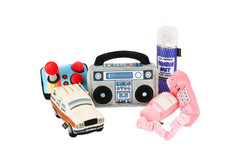Ugh! Whose turn is it to clean the litter box? Despite loving our cats, we don't want to get close to the cat litter box. The problem, however, is that the unpleasant odor of cat urine is starting to become noticeable whenever you enter the house or walk past the laundry where Fluffy does its business.
Don't blame the cat. The fault lies with you. Instead of feeling guilty for neglecting the cat's litter box, get a trash bag and become a good cat owner.
But there is a secret that makes replacing cat litter a pleasanter chore-- if you make it a habit and never break the routine. So answering how often to replace cat litter will tell you to change cat litter with fresh litter every two to four weeks. However, you have to scoop the droppings daily. There's no other way around it!
Now it's your turn to provide a clean litter box to make a cat happy.
What's in Cat Litter and How Does It Work?
We train our cats to use litter boxes, and even new rescue kittens are surprisingly quick at picking up the habit. Then we gradually neglect our litter box maintenance hoping that by some Cat-God miracle, the clumping cat litter and unpleasant odors will miraculously vanish.
Go to any supermarket, pet supply store, or discount store, and there are a hundred options for cat litter boxes, litter brands, and types of litter:
- Clay litter
- Silica gel litter
- Biodegradable litter
- Clumping litters
- Pine litter
- Wheat, grass, corn, walnut shell litter
- Paper litter
- Cheap litter
Cat Litter Types Defined
Cats are finicky, but most, unless they have a severe sensitivity to a particular type, will go with clean forms of clumping litter. Finding a litter that is easy for your family takes some experimenting. Otherwise, it can get messy, and the last thing anyone wants is a trail of kitty litter throughout the house.
Bentonite Clay
This traditional clay clumping cat litter forms into clumps or pucks when moistened. It also helps to absorb and trap litter box smells. It's easy to scoop and dispose of in the litter box. The downside is that it's not great for the environment.
Non-Clumping Litter (Clay)
No surprise, it doesn't clump or absorb odors. Often baking soda and charcoal are additives to help with odor, requiring frequent litter box cleaning. It's messy to scoop from litter boxes.
Silica Litter
Silica, sometimes known as crystal litter, is made up of quartz sand and is excellent at binding large amounts of liquid in the litter box while also neutralizing odor. It's also less dusty and clumps for easier scooping.
Biodegradable Cat Litter
As the name suggests, it's an environmentally-friendly cat litter format made from recycled paper or sustainable plant material. It's terrible at clumping, but it absorbs liquid urine well and helps to keep the litter box clean. It's also a better choice for sensitive paws. This category includes walnut, grass, corn, and pine litter.
Cheap Litter
Cheap clay litter is frustrating and a waste of money, even if you have to fill multiple litter boxes. It makes scooping detestable, and the cat carries the kernels all over the house.
Your feline friend doesn't care about the brand or the type. It cares about doing its bathroom habits in a clean cat's litter box. If those needs are unmet, your cat might use the laundry basket or the expensive Indian rug as a cat box. Suitable litter paired with the best automatic litter boxes is advantageous to cats and cat owners.
Importance of Replacing Cat Litter
Foremost, replacing litter is hygienic for the entire family. Who wants the poor cat to do its business in a filthy box only to carry dirty kernels to its snuggle bed, knowing what those paws walked over? Change the litter frequently if more than one cat shares a box to avoid the litter box smell.
A list of potential diseases if you don't clean litter completely:
- Cat-scratch disease is a bacterial infection affecting adults and children with weak immune systems.
- Salmonella affects the cat, then infects people with diarrhea, fever, and stomach pain, and can lead to hospitalization.
- Cat pee omits a toxic gas called ammonia which is harmful and can cause asthma attacks or even pneumonia.
- Roundworms are nasty parasites that pass onto humans and lead to diarrhea, weight loss, nausea, and more. Call your vet and doctor.
Cats are clean animals. If you don't clean the litter box, your cat is walking traces of poo and pee all through the house.
Signs That Indicate It's Time to Change the Cat Litter
Let your nose be your guide. A clean litter box doesn't smell. An offputting smell is a sure sign of a dirty litter tray. As a rule of thumb, the number of cats should dictate how many litter boxes you need, though some cats share if you consistently scoop the litter tray.
Cats' Behavior
Cats are fantastic communicators. They tell us when they're happy and dislike something and leave us clues or tokens of appreciation. If you're not regularly cleaning the litter box, your cat will signal clear instructions to change cat litter.
Cat pee is notoriously tricky to get out of carpets and soft fabrics like cushions and sofas. Decoding your cat's behavior might get difficult if you're not paying attention to their demands.
Litter Type
It's never been easier dealing with kitty litter or cleaning the box. There are so many wonderful and helpful gadgets on the market there is literally no excuse for not changing the litter.
The type of litter you buy will direct how often you need to clean and disinfect the litter box. A better quality product means less time spent scrubbing a dirty litter box.
However, some cats have unique bathroom demands, and diabetic cats might urinate more frequently.
Number of Boxes
Cats demand their own litter box so they don't have to share with Felix, Morris, and Puss in Boots. If you're limited on space and have more than one cat, an automatic self-cleaning box is a good alternative.
Good advice is to have one litter box per cat. If you live in a large house, make sure a cat litter box is easily accessible from anywhere in the house. If you have the space, four litter boxes per three cats for odor control :)
Smell
Cat urine tends to build momentum if you don't clean it daily. The unmistakable ammonia scent sends warning bells that it's time to change cat litter more frequently. Although they're not very environmentally friendly, some people have good luck with litter box liners.
Number of Cats
One box per cat is the rule. Some cats don't mind sharing, but be cognisant about cleaning throughout the day. And just because they didn't mind sharing before, the dynamics can change quickly.
How to Clean a Litter Box and What Products to Use?
The secret to cleaning a litter box is to form a routine and bi-monthly or monthly maintenance. The main thing is to clean it frequently. Pregnant women should use extreme caution when handling cat litter.
Traditional litter boxes are easy to clean. If you keep up the daily routine, it isn't that offensive. Self-cleaning litter boxes are the cat's meow, but you must take out the waste and teach the cat about using the litter box.
Things you need for the cleaning process
- Gloves
- Trashcan and bag
- Broom and dustpan
- Fresh litter
- Dishsoap or a mild solution of bleach disinfectant* or a splash of rubbing alcohol to sterilize, or vinegar
- Access to water
- Access to dump
- Paper towel
Don't do this
- Dump any kitty litter down the toilet (unless your best friend is a plumber).
- Don't use "more is better" with bleach. A few drops are enough.
- Don't use harsh cleaning chemicals, as cats are very sensitive to smells.
Dispose of the old litter and wipe any residual debris off; wash the tray outside or with a bucket and disposable cloths. You can always wash it at the wand car wash and use the same litter box again. Disinfect, but don't use highly scented products. Dry thoroughly and fill with clean litter.
If you're tired of cleaning the traditional litter pan and the daily upkeep, try a automatic self-cleaning litter boxes, provided your cat is comfortable using these facilities.
How to Change Litter Boxes
Remember that cats communicate, and they don't instantly adapt. Some cats will send you a clear signal when they don't like the new system if you recently changed the box, litter, or location. It's best to listen; it's not an argument you'll win. A sure sign that the cat isn't using the replacement litter box is that there's no deposit.
If you want to upgrade to an automatic litter box, do it in steps. Place it where the old system is but allow the cat the option to visit the old latrine. Gradually move the old box further away.
Some people have luck with enticing the cat into the new litter system with cat nip. Allow the cat time to adjust, and never turn the waste removal on until the cat is comfortable.
How to Stop Cat Litter From Smelling
You can't mask the smell with fancy air fresheners, but not for long. The secret to stopping cat litter from smelling is diligently scooping wet and dry waste. Have a routine, and remove it more than once a day if your cat goes frequently or you have multiple cats.
Another tip is to get your kitten trained in an automatic litter box. Use top-quality traditional clay litter or biodegradable products. Cleaning the litter box daily is also a great way to perform a health check on your cat. If you have a routine, you'll see changes in your cat's bathroom behavior which can sometimes indicate problems.
Conclusion
Kittens are typically easier to toilet train, and it's a great way to introduce them to automatic litter boxes immediately. Most cats use the litter box and clumping litter without problems. Clumping litters help the home smell fresh if you change the litter often.
Never spring drastic changes on your cat, and respect their need for a clean facility with privacy. They don't need the dog watching when they do their thing.





